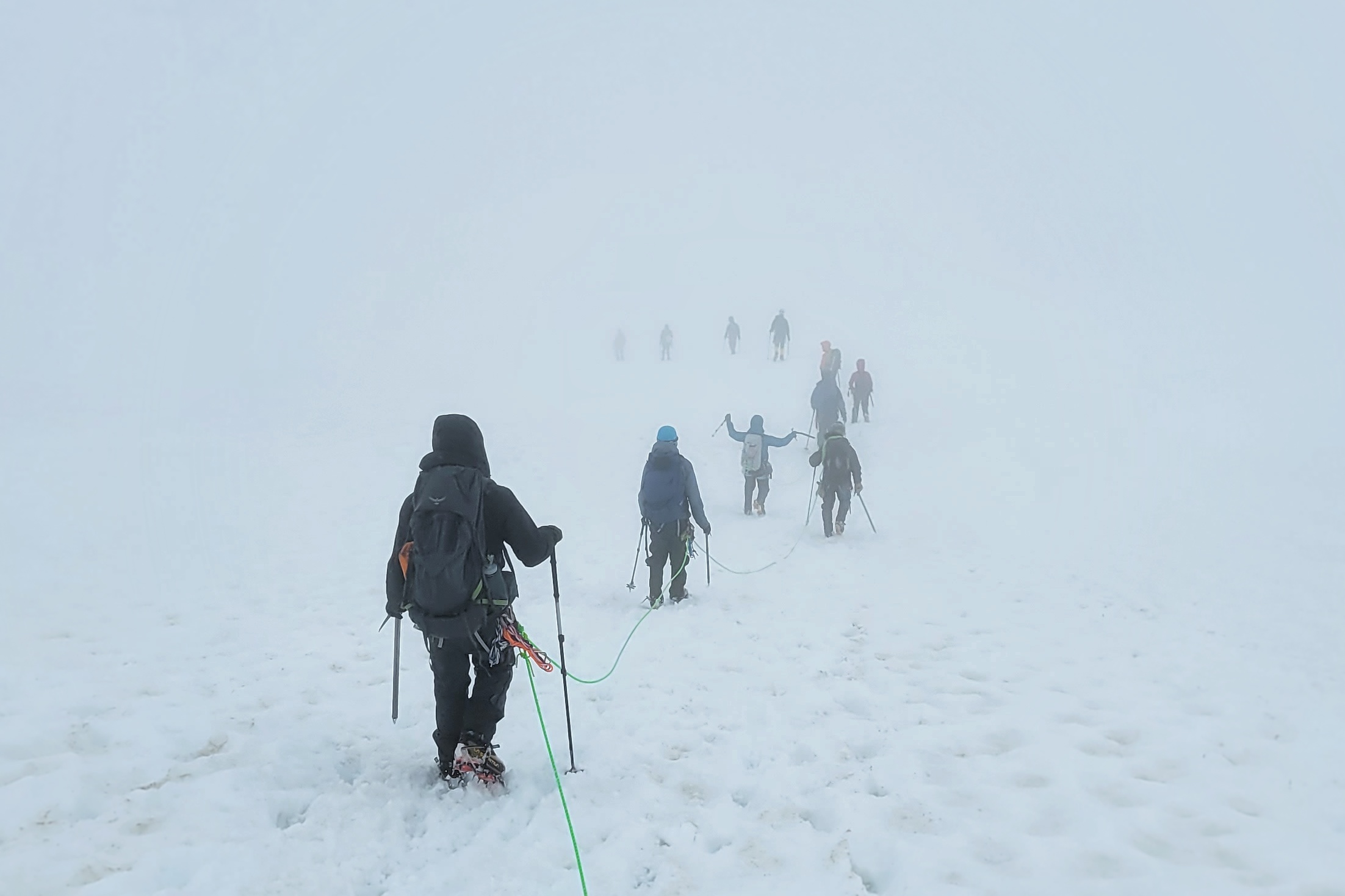On a recent expedition up Mt. Baker in the Cascade mountains, I embodied my meditation practice in an unexpected way.
It was the day after the 4th of July when many people were heading back to work after a holiday. I was instead gathering all my critical layers of clothing and gear at 12:30 a.m. for a 2:00 a.m. summit attempt, while heating up a cup of instant coffee on my camping stove in my tent.
After a 15-minute delay due to pouring rain, our guide told us to hustle up and off we went, becoming a snaking line of headlamps starting their way up the 5,000-foot ascent. I found my flow as my steps synced up with my team, a steady drumbeat in the background.
Ascending one step at a time in the snow, I began to engage my shamatha, or calm-abiding meditation practice. This practice is sometimes mistaken for a breath practice. While we often use breath as our anchor for the practice, the point of a shamatha practice is experiencing single-pointed attention or presence.
We use shamatha methods to transition into this mindful state of being. In this instance, rather than using my breath as an anchor, I used my five senses.
First, I noticed with my eyes the darkness to the east and the shimmer of city lights reflecting upward on the clouds to the west. While there wasn’t a distinct smell, there was a distinct difference between the cold I’m inhaling into my nostrils and the warmth from my body that created steam on the way out, visible in the glow of my headlamp.
My mouth felt dry and without taste, as nerves around glacial travel whirled throughout my physical body. The aforementioned drumbeat of legs progressing up the hill was prominent in the background, but so too was the steady beating of my heart and the sound of my elevated respiration. The air was cold and damp on my clothing, my core was warm and sweating inside my jacket, and the small exposed area of my face not covered by clothing felt cold in the crisp pre-dawn air.
This preliminary practice allowed me to become present, dropping the future desire to summit and instead enjoying the journey along the way.
After about an hour of moving uphill, we arrived at the “portal” or the entry onto the glacier. Here, it was time to get out our ice axes, put on our crampons (a metal plate with spikes fixed to a boot for walking on ice), rope up as teams, and begin moving as units on the very much alive and changing glaciated terrain. We moved across beautiful aquamarine crevasses (a deep open crack in a glacier), while mindfully managing our ropes and the terrain together as a team.
As dawn arose, so too did white-out conditions, intense winds, and downpour. At about 3,000 feet and over four hours of exertion, our guides called it, and we turned back around. There would be no summit this time around.
While the entire experience was, for me, a meditation practice, as a meditation teacher who has taught hundreds of people how to meditate and guided thousands in meditation sessions, I found a few specific aspects of my mountaineering expedition to be highly applicable to our meditation practice:
1. Learning how to do it right is important.
I had spent the prior days learning how to navigate glacial terrain and appropriately use gear because I didn’t yet have these skills. Similarly, I have found that, unfortunately, many of us confuse guided meditation with “how to meditate,” and that couldn’t be further from the truth. In guided meditation, someone is helping us to anchor our mind. When learning “how to meditate,” we develop the necessary skills to practice and anchor our mind on our own. Learning these skills gives us a powerful foundation for navigating life more mindfully both on and off the cushion.
2. Being in a group setting helps a lot.
Leaning on my peers and their feedback and experience, I was able to accelerate my understanding of these new skills. So too, in meditation. While it may seem like a solo sport, group meditation offers accountability, a forum for questions, and camaraderie bar none.
3. Sometimes things won’t go the way you think they will, so be prepared.
If you’re like me (and every other practitioner I know), and you encounter days of monkey-mind, sleepiness, anxiety, and distractions during your practice, being prepared and armed with antidotes is important to prevent becoming discouraged. Life is hard enough; our meditation practice doesn’t need to be!
A good teacher will arm you with many different tools appropriate for different circumstances.
4. Having a teacher is key.
As we approached crevasses, the weather disintegrated, and the terrain became increasingly steep, I was grateful for our instructors. They had shared their knowledge and were taking us safely on the most direct route, something I couldn’t have done on my own. When we meditate, we are reshaping our minds, and we need someone with training and experience to help navigate this new terrain effectively.
If we are taking time out of our busy lives to sit, doesn’t it make sense to do so optimally?
5. Mindfulness matters!
The ability to navigate team dynamics with knives on my feet, a rope around the waist, and an axe in my hand while moving up and down slippery ice and snow really brought home to me the power of mindfulness. Suddenly, those early morning meditation practices, weekend group meditation sessions, and solo retreats were paying off tangible mindful dividends on ice and snow.
While I didn’t get to the summit, this experience was anything but a failure. Even when we find our practice to be difficult, as long as we make an effort to sit and befriend our mind, we have successfully meditated.
Difficult meditation sessions give us critical feedback about what’s going on within and outside of us, and that’s how we create the bridge between our lives both on and off the cushion.
The joy is in the journey.

~
Please consider Boosting our authors’ articles in their first week to help them win Elephant’s Ecosystem so they can get paid and write more.







Read 10 comments and reply